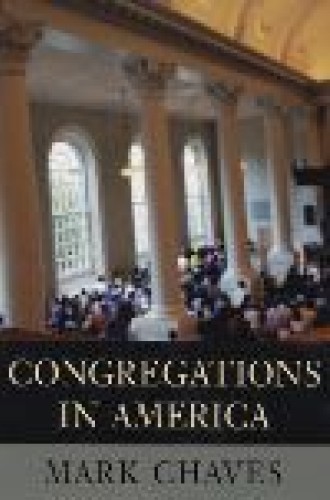Churches inside and out
Outside my office door are boxes of free books and journals left behind by a recently retired professor. The two books reviewed here are unlikely to land in such a pile, as each makes a classic as well as timely contribution to our understanding of American religious organizations. Sociologists Mark Chaves, Cynthia Woolever and Deborah Bruce take commonly held assumptions about congregations, test them empirically and revise the way we think about them.
Chaves argues that “the most significant activities and contributions of congregations to American society are cultural in a way that is not sufficiently appreciated by many.” Congregations are primarily occupied with the transmission of religious meaning, and they facilitate a surprising amount of artistic activity as a by-product. Like it or not, churches “do not mainly pursue charity or justice through social services or politics.”
This finding is timely in an election year in which faith-based initiatives and the Charitable Choice movement have been contested issues. In a national survey of churches, mosques, temples and other religious groups, Chaves finds that the median amount spent on social services by those congregations active in providing such services is approximately $1,200, or less than 3 percent of the congregation’s budget. Larger congregations with more resources provide more social services, as do congregations in poor neighborhoods, especially if they have college-educated members. The typical congregation active in providing social services is a downtown congregation whose members live in middle-class suburbs. Moderate and liberal Protestants, Catholics and Jews provide more social services than do conservative Protestants. Race is not a significant factor. Staff rather than volunteers typically drive this work. While the whole congregation may identify with the work, relatively few members give their time to it.
Further, congregations tend to address short-term immediate needs. There is no reason to believe they are better than government agencies at forging holistic relationships with those in need.
Liberal congregations collaborate with social service organizations in programs providing food, shelter and clothing. African-American congregations closely collaborate with secular agencies to provide mentoring, substance abuse prevention, job training or employment assistance programs. Conservative Protestants, who provide fewer social services than other congregations, tend to work independently.
Chaves’s notable conclusion is that “congregation-based social services do not present us with a meaningful alternative to the services already provided by our community welfare systems.” Moreover, “congregations’ social service agencies depend on collaborations with secular and government agencies.”
Chaves’s research leads to surprising revelations about religious groups’ engagement in politics. He finds that white moderate and liberal congregations do not engage in more political activities than congregations of other traditions. The high level of activism that characterized their clergy in earlier decades is no longer in evidence. While these groups are significantly more likely than other congregations to hold classes about other religions and to engage in “bridging activities” with their communities, their activities are rarely political. Catholic and African-American Protestants outpace both liberal and conservative white Protestants in this area. Catholics are most likely to lobby elected officials and organize demonstrations and marches. African-Americans tend to sponsor voter registration drives and ask candidates and politicians to make speeches. White conservative Protestants and evangelicals distribute voter guides as their main political activity.
Perhaps the most fascinating part of Chaves’s book is his discussion of worship, the arts and culture, which he finds to be the primary work of congregations. In a highly nuanced analysis, Chaves explains why certain theological traditions select particular worship elements (such as the use of incense) and not others (such as jumping and speaking in tongues) from the 29 possibilities he lists. He notes patterns by class and age and constructs a model mapping out traditions along two axes: “ceremony” and “enthusiasm.” The change in collective religious practices over time is explained not so much by Max Weber’s routinization-of-charisma argument as by an ecological interpretation. New religious traditions choose their worship practices in relation to what already exists in the religious environment. Change is relatively small and slow. Newer traditions tend to be low on ceremony and high on enthusiasm. There is an increasing preference for informality in conjunction with worship forms that endure.
Chaves has a message for the general public: “Congregations’ worship services, where 60 percent of the population hear live music in a given year, are the single most common type of event at which live music is heard in American society.” Furthermore, Americans view “a hefty proportion” of all live drama and dance in the worship services of their congregations. More groups perform in community centers than in places of worship, but more people attend the performances in places of worship. Not only does society undervalue congregations as places that produce and host the arts, congregants themselves do. How many of us would have thought that “congregations facilitate art, and perhaps, on occasion, even beauty, more commonly and more intensively than they pursue either charity or justice”? Reading Chaves’s book is a little like stepping on the bathroom scale. What we see may not fit our image of ourselves. But it gives us a reality check, helping us consider what we want to do about the mission of the church.
Woolever and Bruce also debunk myths about congregations. For example, they counter the typical notion that congregations grow because the majority of worshipers are inviting others to attend services. They find that visitors need a reason to return. An aggressive campaign to invite newcomers is not associated with church growth. In fact, “sharing faith is actually a negative predictor of growing in numbers.”
Similarly, the idea that large congregations attract new people at faster rates than smaller ones is a myth. Whether a congregation is regarded as “welcoming” is related not to its size but to its theology. By this measure, conservative Protestants are more welcoming of newcomers than Catholics, mainline Protestants or historically black denominations.
Woolever and Bruce identify qualities that are evident in strong congregations. These strengths are aspects of the organization’s dynamics, which operate consistently, “whether or not the worshipers or leaders are aware of it.” They are imbedded in the behaviors, beliefs and values of the majority.
In a survey of members and leaders of more than 2,000 congregations, Woolever and Bruce sifted out the top ten qualities they call “strengths.” Their analysis is based on the congregations that scored in the top 20 percent on any one or more of the ten indices—what Woolever and Bruce call “beyond-the-ordinary congregations.” They tested correlations of these strengths with size of congregation, theological tradition, age profile, growth in numbers and other variables.
Smaller congregations (those with fewer than 100 in worship) will be heartened to learn that they exhibit—in greater degree than do mid-size and large congregations—most of the ten strengths: growing spiritually, meaningful worship, participating in the congregation, having a sense of belonging, sharing faith and empowering leadership. Conservative Protestant and historically black denominations, as well as congregations with a lower average age (less than or equal to age 52), also exhibit these strengths in greater degree. Woolever and Bruce’s overall finding is that all congregations have strengths, and that they require multiple strengths to be effective. Congregations must focus not on one thing only, but on the multiplicity of their strengths.
Both books base their research on the same large, nationally representative sample of congregations that Chaves created for his National Congregations Study, with the assistance of the National Opinion Research Center at the University of Chicago. They rely on different kinds of data samples, Chaves on face-to-face interviews with key informants—a minister, priest, rabbi or other staff person or congregational leader—and Woolever and Bruce on written surveys sent to a variety of congregations and filled in by worshipers on a particular day.
Both books make a tremendous contribution to our knowledge of the 300,000 congregations in America. Chaves’s quantitative analysis is augmented by references to other quantitative, case and qualitative studies, theoretical resources and historical analyses. This makes Congregations in America a first-rate work of sociological scholarship. Woolever and Bruce’s work addresses clergy and laity who are conducting strategic planning for their congregations. They make their analysis accessible to a general audience and enliven it with amusing cartoons and light-hearted references to that American classic, Frank Baum’s The Wizard of Oz. Both books would be valuable additions to any church’s library or professor’s syllabus.






